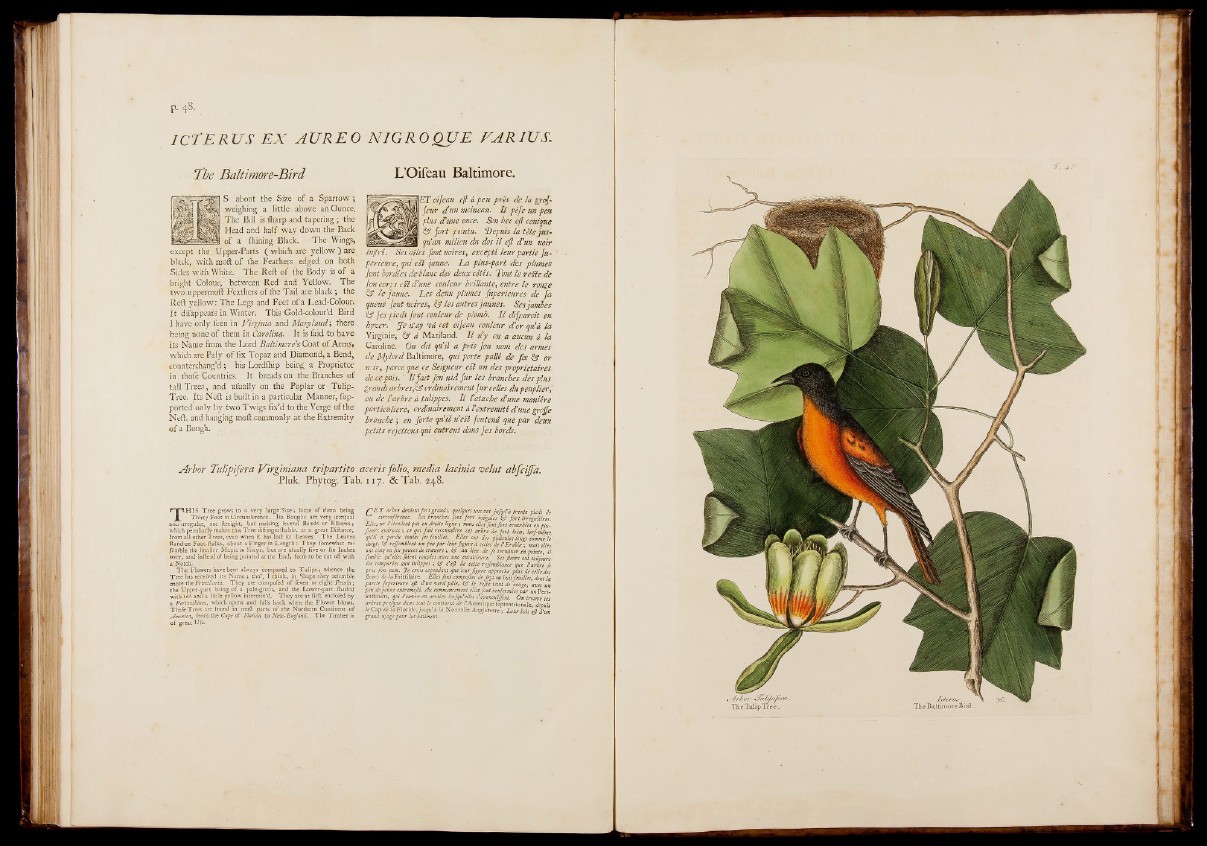
F 48- .
I C T E R U S E X A U R E O N IG R O Q U E V A R 1U S .
The Baltimore-Bird L’Oifeau Baltimore.
5 about the Size of a Sparrow;
.weighing a little above an Ounce.
The Bill.is (harp and tapering; the
Head and half way down the Back
o f a ihining Black, The Wings,
except fhe Upper-Parts ( whidi are yellow ) are
blacky with moft o f the Feathers edged on both
Sides with White. The Reft of the Body is of a
bright Colour; between Red and Yellow. The
t.wp uppermoft Feathers of the Tail are.black; the
Reft yeJlowj .The Legs and Feet of a Lead-Colour.
It disappears in Winter. This Gold-colour’d Bird
I have only feen in' Virginia and Maryland; there
being none of them in Carolina* It is faid to have
its Name from the Lord Baltimore’s Coat of Arms».
Which are Paly of fix Topaz and Diamond, aBend,
counterchang’d ; his Lordihip being a Proprietor
in thofe Countries. It breads on the Branches of
tall Trees, and ufually on the Poplar or Tulip-.
Tree. Its Neft is built in a particular Manner, fup-
ported only by two Twigs fix’d to the Verge of the
Neft. and hanging moft commonly at the Extremity
of a Bough. ,
reau e(l à peu près de la grqf*
<f un moineau. I l pèfe un peu
Tune once'. Son bec eft conique
rt pointu. Depuis la tête ju s-
milieu du dos i l ejl d ’un noir
Izijtré. Ses ailes font noires, excepté leur partie Ju -
perieure, qui eB jaune. L a plus-part des plumés
font bordées de blanc des deux cotés. Tout le reB e de
fon corps c il d’une couleur briUante, entre le rouge
le jaune. Les deux plumes fuperïeures de fa
queue font noires, & les autres jaunes. Ses jambes
& ¡es pieds font couleur de plomb. I l difparoit en
hjrver. J e n’ay vü cet oifeau couleur d ’or qu’à la
Virginie, à Mariland. I l n’y en a aucun à la
Caroline. On dit qu’il a pris fon nom des armes
de Mylord Baltimore, qui porte paUé de fix àf or
noir, parce que ce Seigneur eB un des propriétaires
de ce pais. ' I l fait fon'nid fur les branches des plus
grandsarbres, & ordinairement fu r celles du peuplier
ou de l ’arbre à fulippes. I l l ’atache cCune manière
particîtliere, ordinairement à l’extremité dune groffe
branche ; en forte qu’iln ’eB foutenû que par deux
petits rejetions qui entrent clans fes bordsi
Arbor Tülipifera Virgmiana tripartito acefis folio, media lacinia velut abfciffa.
Pluk. Phytog. Tab. 117. &Tab. 24.8.
TH IS Tree grows to a very large Size; fome of them being
Thirty Foot in Circumference. Its Boughs are very unequal
anti irregular, not ftreight, but making feyeral Bends or Elbows;
which peculiarly makes this Tree diftinguiihable. at a great Diftance,
from all ocher Trees, even When it has loft its Leaves. The Leaves
ftand on Foot-ftalks, about a Finger in Length : They fomewhat re-
¡[fcmble the fmaller Maple in Shape, but are ufually five.or fix Inches,
over, and inftead of being pointed at the End, feem to be cut off wi,th
a'.Notcb..
The Flowers have been always compared to. Tulips; whence the
Tree has received its Name; tho’, I think, in Shape they relemble
more the Frittillaria. They are compofed of feven or eight Retain;
the Upper-parc being of a pale-green, and the Lower-part ihaded
with red and a little yellow intermix’d. They are at firft encloled by
a Peritinlhiunij which opens and falls back when the Flower blows.
Thefe Trees are found in moft parts of the Northern Continent of
America, from the Cafe of Florida to New-England. The Timber is
of great Ufe.
Q E T arbre devient port grand-, quelques uns ont jufqu'à trente pieds de
circonférence. Ses branches font fort inégales W fort irreguliêres.
Elles ne s'étendent pas en droite ligne -, mais elles font fort ecourbées en plu-
fieurs endroits ; .ce qui fait reconnaître cet arbre de fort loin, lorf-même,
qu'il a perdu toutes fes feuilles. , Elles ont des pédicules longs comme le
doigt, & reffemblent un peu par leur figure à celles de l'Erable -, mais elles
ont cinq ou fix pouces de travers ; (ft au lieu de fe terminer en pointe, il
femble qu' elles fuient coupées avec une entailleure. Ses fleurs ont toujours
été comparées aux tulippes f 6? c'eft de cette reffemblance que Parère à
pris fon nom. Je crois cependant que leur figure approche plus de celle des
fleurs de la Frittilaire. Elles font compofées de fept ou huit feuilles, dont la
partie fuperieure eft d'un verd pâle, & le re/le teint de rouge, avec un
peu dejaune entremejlé. Au commencement ellef font renfermées par un Peri-
anthium, qui s'ouvre en arriére lorfqu'elles s’épanouijfent. On trouve ces
arbres prefque dans tout le continent de /’Amérique feptentricnale, depuis
le Cap de la Floride, jusqu’à la Nouvelle Angleterre ; Leur bois eft d’un
grand ufage pour les balimens•